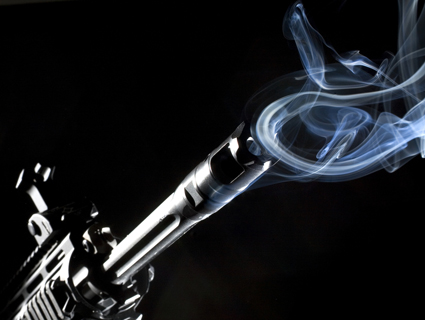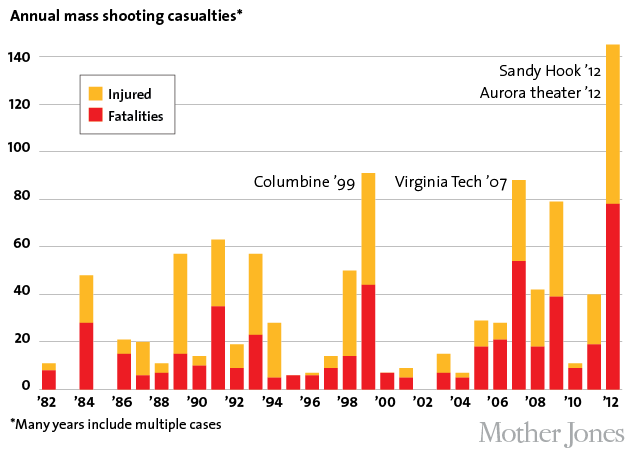As lawmakers across the country and in the nation’s capital debate possible restrictions on high-capacity magazines, one question emerges: Are these ammunition-feeding devices, which allow a shooter to fire many times without reloading, in fact commonly used by mass killers? We examined the data from Mother Jones‘ continuing investigation into mass shootings and found that high-capacity magazines have been used in at least 31 of the 62 cases we analyzed. A half-dozen of these crimes occurred in the last two years alone. (With some of the cases we studied, it remains unclear whether high-capacity magazines were used. We included all those involving magazines with more than 10 rounds; in many of the cases their capacities were far greater. For more details, jump to our data set below.)
In the shooting that injured Rep. Gabby Giffords in Tucson, Arizona, Jared Loughner fired 31 rounds in 30 seconds, killing 6 and injuring 13. Inside a movie theater in Aurora, Colorado, James Holmes used 40- and 100-round magazines to kill 12 and injure an unprecedented 70 victims. At Sandy Hook Elementary School in Newtown, Connecticut, Adam Lanza used high-capacity magazines to fire nearly 150 bullets as he slaughtered 20 kids and 6 adults.
“It turns a killer into a killing machine,” says David Chipman, who served for 25 years as a special agent in the Bureau of Alcohol, Tobacco, Firearms, and Explosives. Outlawing high-capacity magazines won’t prevent gun crimes from happening, Chipman notes, but might well reduce the carnage: “Maybe 3 kids get killed instead of 20.”
With Congress undertaking a highly charged debate over firearms restrictions, many observers are skeptical that Democratic Sen. Dianne Feinstein’s proposal to ban assault weapons will garner enough votes on Capitol Hill. But there may be momentum for mandating universal background checks on gun purchasers, and for outlawing the sale of magazines containing more than 10 rounds. A recent NBC News/Wall Street Journal poll found that a majority of Americans support stricter regulation of firearms sales, and 59 percent believe that high-capacity magazines were significantly to blame in the recent spate of mass shootings.
The problem dates back to long before Newtown. In 1984, the assailant who massacred 21 at a McDonald’s in San Ysidro, California, unleashed more than 200 rounds. School and workplace shootings in Stockton, California, and San Francisco in the late ’80s and early ’90s also involved large magazines, with an estimated 100 shots fired in each case. In 1997, a gunman in Orange, California, fired nearly 150 shots, wielding an AK-47 with a 30-round magazine three years after a federal law banned such assault weapons.
High-capacity magazines also play a role in the daily gun deaths plaguing US cities from LA to Chicago to Baltimore. “A lot of these folks who are driving in their cars and shooting out the window, they’re shooting whatever is in their magazine,” Chipman says. “So if it’s only 10 rounds instead of 20, maybe the kid halfway down the block doesn’t get hit with round 18.”
The 1994 federal assault weapons ban limited magazines to 10 rounds, a threshold generally accepted by law enforcement officials and policy makers. Feinstein’s bill aims to reinstate this limit, as does legislation introduced by Democratic Sen. Frank Lautenberg of New Jersey. Seven states have some restrictions on high-capacity magazines; a new state law passed in New York limits magazines to no more than seven rounds.
Gun rights advocates argue that larger magazines, which can add convenience for gun owners who enjoy sport shooting, are simply “standard” for semi-automatic handguns and rifles. The debate turns semantic quickly, in the same contentious vein as the one over the definition of “assault weapon.” Law enforcement officials, meanwhile, tend to agree that no law-abiding citizen needs high-capacity magazines for self-defense.
Gun rights advocates also commonly argue that mass shooters could kill just as easily by rapidly reloading smaller magazines, and that a ban would make no difference. But such capability requires extensive training under intense conditions, according to Chipman. “Anyone who’s been a cop or in the military knows that that’s not something you can do unpracticed,” he says.
The Tucson mass shooting is telling here in another regard: It was only after Loughner had emptied his 33-round magazine and paused to reload that bystanders were able to tackle him and end the carnage.
Click here for the full Google spreadsheet view of the data below. To explore the rest of our yearlong investigation into gun laws and mass shootings, click here.















